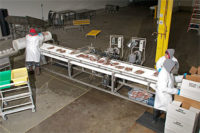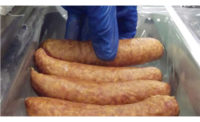Ready-to-eat (RTE) protein producers are more frequently being asked to deliver clean-label products by their retail, club-store and foodservice customers. The demand is easily supplied by removing bacteriocins commonly used in food production today. The “catch” is, customers still demand the same (or better) shelf life, and removing these preservatives negatively impacts it.
Enter high-pressure processing (HPP). This cold pasteurization technology is gaining a foothold as a reliable food-preservation technology. Millions of pounds of RTE meats are pasteurized with high pressure each week. Producers and third-party HPP tolling centers around the country have purchased the technology, are leveraging HPP’s benefits for their existing customers and are finding new market opportunities.
The key benefits most processors are interested in are pathogen control and shelf-life extension. HPP technology delivers safe foods by inactivating Salmonella, E. coli O157:H7, Listeria monocytogenes and other vegetative bacteria. Varying the HPP process pressures and hold times directly impacts the log reduction capabilities of the technology.
However, what typically “pays the bills” is that HPP, in many cases, doubles or triples product shelf life. It accomplishes this by killing the microorganisms, i.e. yeasts and molds, that cause spoilage. Subsequently, the lag phase of lactic acid bacteria is increased and frequently becomes the spoilage indicator.
As many producers are finding, consumers are requesting more low-sodium products in their diets. Here again, while producers can easily adjust the sodium levels in their ingredient decks, reducing sodium (which also serves as a preservative) negatively impacts the product shelf life. This can be offset through the use of HPP — and in many cases, shelf life can be doubled.
Of recent note is the application of HPP for raw proteins. Protein processors are searching for solutions to address inherent food-safety concerns. On the beef side of the business, the organism of primary concern is E. coli; with poultry, it is Salmonella. By understanding what the end goal is, processors can balance the HPP pressure and hold time to deliver the needed results. HPP researchers have learned to use cold processing conditions to minimize the denaturing (color change) of raw proteins. Today, whole-muscle products and trim are being high-pressure pasteurized in 15- to 30-pound bags and then reintroduced for grinding and further processing. The processor gains the benefits of HPP to address food-safety issues associated with its incoming proteins and uses good GMPs to properly manage its operations.
Organic processors also see HPP as a go-to, “friendly” technology. They can use the increased shelf life to ship to larger geographic markets. Knowledgeable retailers have significantly reduced “shrink” and can many times reduce the cost of labor associated with pulling out-of-code-date products from their shelves. Some companies choose to promote their use of HPP, while others want to market only the benefits of the technology. There are no mandates requiring that HPP be mentioned on the label.
HPP is not a “silver bullet,” but as with other new food-preservation technologies, it has found a growing acceptance in the food industry.
Also in this month's issue: HPP: The story has just begun





Report Abusive Comment